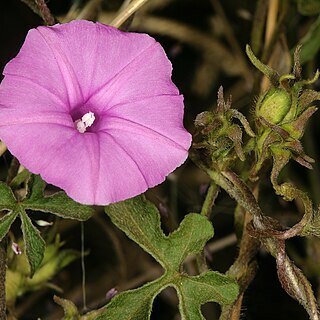Leaf lamina palmately 3-or 5-lobed nearly to the base, 2–11 × 2–14 cm., green or yellow-green, with thin appressed pilose hairs above, densely covered with a white cobwebby tomentum beneath except on the main nerves and main veins which are covered with yellowish or brownish stiff, appressed to patent hairs and thus clearly marked out; lobes varying from obovate to narrowly elliptic, lanceolate, oblanceolate, linear-lanceolate or ovate-lanceolate except the basal ones in 5-lobed leaves which are shorter and relatively broader, apex or central and first pair of lobes subacute to acuminate, often cuspidate; margins entire or subentire, more or less distinctly ciliate; petioles more or less as long as the leaves, slender or stouter, pilose.
Perennial herb. Stems procumbent or suberect. Leaves with blade deeply palmately 3-or 5-lobed, 20-40 mm in diameter, lower surface densely covered with white cobwebby hairs and prominently veined. Flowers: in a dense, 1-few-flowered head; calyx lobes narrowly ovate, acute, hairy; corolla 12-20 mm long, magenta-purple, mauve, cream-coloured or white with darker magenta centre; Jan.-Mar. Fruit a subglobose, glabrous capsule, 6-8 mm in diameter; seeds pubescent, hairs often in small tufts and sometimes with long hairs along angles.
Inflorescence a dense few-flowered pedunculate head, rarely (by reduction) flowers solitary; peduncle up to 12 cm. long, slender or stouter, pilose as in stems and petioles; bracts linear or lanceolate up to 15 mm., hairy; pedicels very short.
Perennial climbing herb. Leaves, sepals and seeds as in var. magnusiana. Corolla 20-32 mm long. Flowers magenta-purple, mauve, cream or white with darker magenta centre.
Corolla funnel-shaped, magenta-purple, mauve, cream, or white, with darker magenta centre, 12–32 mm. long; midpetaline areas pilose.
Seeds pubescent, with the hairs often arranged in small tufts and sometimes with long white hairs on the angles in upper half.
Stems twining, climbing, prostrate or suberect young ones, up to several metres, slender or stouter, pilose.
Sepals somewhat unequal, lanceolate, acute, 6–15 mm. long, accrescent in fruit up to 20 mm., hairy outside.
Perennial, forming several to many annual stems from a woody taproot.
Capsule subglobose, glabrous.

